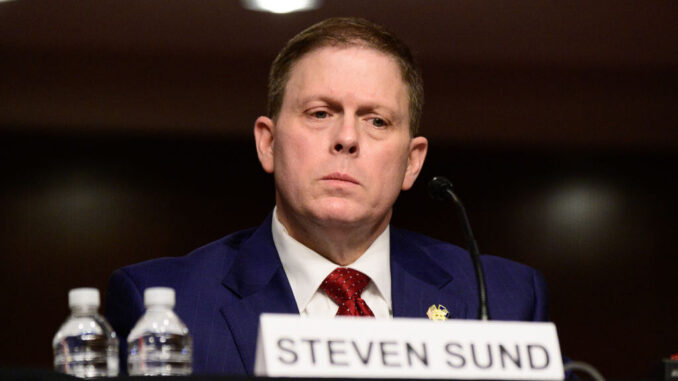
The Jan. 6 breach of the U.S. Capitol was a coordinated, well-planned attack, not a split-second decision of impassioned, angry Americans, the former chief of the Capitol Police and other security officials said in their first public testimony.
Steven Sund, who resigned as Capitol Police chief shortly after the insurrection, and other officials testified at a joint Senate committee hearing Feb. 23 on security failures surrounding the riot, including that the intelligence they received predicted a much different scenario than the one they faced. During the violent attack, five people were killed and 140 officers were injured.
“I witnessed insurgents beating police officers with fists, pipes, sticks, bats, metal barricades and flagpoles. These criminals came prepared for war,” Sund said in his opening remarks before members of the Senate Committee on Homeland Security and Governmental Affairs and the Committee on Rules and Administration.
Carneysha Mendoza, a Capitol Police captain in the Special Operations Division who arrived on scene about 35 minutes after rioters had breached the building, suffered chemical burns on her face that still have not healed.
“In my career I have been activated to work demonstrations with various controversial groups, and I have been called some of the worst names so many times that I am pretty numb to it now,” said Mendoza, who served in the U.S. Army, She described working during the Million MAGA March on Nov. 14, when demonstrators and counter-demonstrators converged on the Supreme Court in disputes over the election of President Joseph R. Biden.

“The civil disturbance unit fought hard that day,” she said.
Capitol Police were expecting the Jan. 6 mass gathering for former President Donald J. Trump to be similar to that of the Million MAGA March, but Mendoza said that in her 19 years with the department, the Capitol riot was “by far the worst of the worst.”
“[Officers] fought extremely hard. I know reports say the battle lasted three hours, but according to my Fitbit, I was in exercise zone for four hours and nine minutes, and many of the officers were in the fight well before me.”
“None of the intelligence we received predicted what actually occurred,” said Sund. “We properly planned for a mass demonstration with possible violence. What we got was a military-style coordinated assault on my officers and a violent takeover of the Capitol building.
“You’re bringing climbing gear to a demonstration, you’re bringing explosives, you’re bringing a chemical spray,” said Sund. “You’re coming prepared.”
Sund referred to two pipe bombs found near the Capitol that he believes were planted to draw his forces away from the Capitol.
“I think there was significant coordination with this attack,” he said.
Robert J Contee III, acting chief of police of the Metropolitan Police Department of Washington, D.C., agreed with Sund’s assessment and referred to the use of hand signals, radio communication and explosives, and the coordinated use of bear spray.
“We’re learning more and more that this was clearly a coordinated effort,” Contee said.
Former U.S. House of Representatives Sergeant at Arms Paul Irving, who resigned under pressure after the attack, testified that “Based on the intelligence, we all believed that our plan met the threat and that we were prepared. We now know that we had the wrong plan. As one of the senior security leaders, I am accountable for that. I accept that responsibility … .”

“We did discuss whether the intelligence warranted having troops at the Capitol,” Irving said. “That was the issue. And the collective judgment at the time was that no, that was not warranted.”
The FBI on Jan. 5 shared social media posts about the planned attack with multiple law enforcement agencies. That information was not passed from the intelligence department of the Capitol Police to Sund.
Sen. Rob J. Portman (R-Ohio) asked about the Capitol Police’s lack of riot gear and Sen. James P. Lankford (R-Okla.) asked about the lack of infiltration training. The answers indicated it was largely due to the cost compared with the likelihood they would need such equipment and training. Additionally, Sund said some equipment had been ordered and was delayed due to COVID-19.
“No civilian law enforcement agency — to include the United States Capitol Police — is trained or equipped to repel an insurrection of thousands of individuals that is focused on breaching a building at all costs,” Sund said. “I acknowledge that under the pressure of an unprecedented attack, a number of systems broke down.”
He also defended the he Capitol Police officers’ actions, saying though “outnumbered and against the odds [they] successfully carried out their mission to protect the members of Congress and the legislative process.”
Sen. Ron H. Johnson (R-Wis.) asked Sund if he regretted resigning in the wake of the attack.
“I certainly do regret resigning. I love this agency, I love the women and men in this agency, and I regret the day I left,” Sund said.
The hearing is scheduled to continue next week with testimony from members of the intelligence community.
(Edited by Kristen Butler and Judith Isacoff)
The post Capitol Invasion: We Were Let Down By Intelligence That Didn’t Predict A Riot Say Police appeared first on Zenger News.
